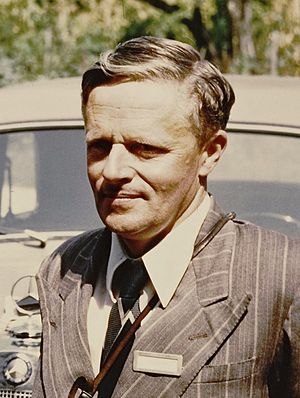Arthur Mourant facts for kids
Quick facts for kids
Arthur Mourant
|
|
|---|---|

Arthur Mourant in 1954
|
|
| Born | 11 April 1904 |
| Died | 29 August 1994 (aged 90) |
| Nationality | British |
| Alma mater | Exeter College, Oxford University |
| Known for | Biological anthropology and distribution |
| Awards | Fellow of the Royal Society |
| Scientific career | |
| Fields | Anthropology and Medicine |
Arthur Ernest Mourant was a British scientist. He was a chemist, a doctor who studied blood, and a scientist who studied genes. He was a pioneer in many fields. These included studying human groups, genes, medicine, and geology.
Contents
Arthur Mourant's Early Life and Studies
Arthur Mourant was born on April 11, 1904. He grew up on the island of Jersey. He studied at University of Oxford. He earned degrees in chemistry and geology in 1931.
Believing in Continental Drift
Mourant was an early supporter of Alfred Wegener's idea. This idea was called continental drift. It says that continents move slowly over time. At first, many scientists did not believe this. But later, it became accepted as plate tectonics. This theory explains how Earth's large plates move.
Starting a Lab in Jersey
After Oxford, Arthur Mourant could not find a job in geology. So, he went back to his home in Jersey. There, he started a special lab. This lab was for studying diseases. It was called a pathology laboratory.
Arthur Mourant's Medical Career
Later, Arthur Mourant studied medicine and surgery. He went to St Bartholomew's Medical College in London. In 1946, he joined a special unit. This unit studied blood serum.
Leading the Blood Group Lab
He then started the Blood Group Reference Laboratory in London. He was the director there for 20 years. This lab became very important.
Pioneering Blood Group Research
Arthur Mourant was a leader in studying blood groups. He looked at how blood groups are spread around the world. This work helped to create a genetic map of the world.
Mapping Human Genetics
He studied and classified blood groups. He looked at many different groups of people. His important book was called The Distribution of the Human Blood Groups. This book brought together all the known facts. It showed where different blood groups were found.
New Science of Anthropology
His work helped to start a new way of studying anthropology. Anthropology is the study of human societies and cultures. Mourant's work showed how genes connect different groups. It helped scientists understand how human populations are related. This had a big impact on medicine. It helped with research into genetic diseases. It also improved blood transfusions and public health.
Discovering New Blood Antigens
Mourant also studied new parts of blood. These are called blood group antigens. He looked at systems like Lewis, Henshaw, Kell, and Rhesus. He also studied biological polymorphisms. These are different forms of genes in a population. He even studied blood characteristics in fish and cattle.
Awards and Recognition
Arthur Mourant received many honors for his work. He became a Fellow of the Royal Society. This is a very high honor for scientists. He also received the Huxley Memorial Medal. This was from the Royal Anthropological Institute. He won the Landsteiner Memorial Award. This award came from the American Association of Blood Banks. He was also an honorary member of the Human Biology Council.

